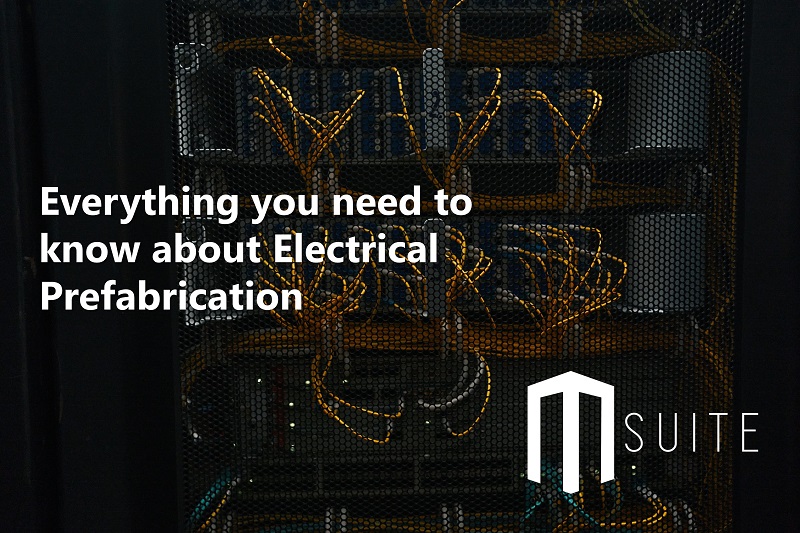Although prefabrication strategies have been utilized in construction for quite a long time, they are fairly new to the electrical industry.
Modular construction, building offsite, and assembly on the jobsite connect components in a warehouse or facility before delivering partially or finished parts to the jobsite for installation. Working in a controlled environment has many benefits, including increased worker safety in high-risk zones and maximizing productivity through easily repeatable tasks.
As electrical contractors search for better approaches to expand efficiency, creating pre-assembled electrical frameworks and components speed up installations and increase their capacity. Electrical prefabrication incorporates parts from switches and receptacles to the inside floor and wall equipment.
Electrical prefabrication is a result of sound planning. Utilizing prefabrication can fail or succeed depending upon the quality of shop digital drawings and information you have for creating the components. While prefabricated components need not be restricted to just small items, contractors should be extremely sure of what they’re doing in more significant efforts. Projects are easily derailed from even minor mistakes in drawings or specifications.
Many construction companies are integrating prefabricated electrical components such as panel builds and lighting bundles into modular data center skids with the rapid increase in data center projects. Other projects include green structure initiatives and reducing waste on construction jobsites.
Advantages of Electrical Prefab
Increases Installation Efficiency
Electrical assemblies are worked upon with precise specifications. Once they are pre-assembled and conveyed nearby, they should be connected with the electrical supply to begin working, exceptionally expanding effectiveness and efficiency. This likewise restricts lost time recovering forgotten instruments and materials since a large portion of the work is already complete.
Reduces Labor Costs and Less Material Handling
Prefabrication setup offsite requires less time, sparing work costs by performing monotonous installations. In addition, the need for licensed electricians on-site reduces, thus increasing productivity as they do not have to work on dangerous sites. Moreover, the task will require fewer prefab workers in the field, bringing about a significant decrease in labor costs and improved productivity.
The prefabrication process is viewed as a manufacturing function so the contractors can make progress with fewer specialists. In addition, the workshop can utilize other labor, unlike a building site where the electrician must install at the construction site. Prefabrication also eliminates unnecessary material handling on construction jobsites. As materials are delivered to specific areas of the jobsite, individual assemblies become part of the standard construction process.
Improved Quality and Faster Turnaround Time
With completed shop drawings, the component can be pre-assembled before the structure is built, shortening the project schedule. Prefabs provide on-site, offsite, and other hidden advantages. For example, the quicker establishment at the place of work lessens the task term. In many cases, prefabricated modules are cutting installation times by half. Fewer materials and less activity at a jobsite can help complete the project faster, reducing the possibility of mishaps and deferrals by installing quality control checkpoints before delivery.
Moreover, delivering all the individual parts to the workshop for assembly limits the degree of material handling. This means an easy-to-manage supply chain. Fewer materials reduce clutter, waste, and the requirement for additional space for storage. Prefabrication enables construction firms to mitigate delays due to poor weather by working in controlled environments leading to higher output.
Prefabrication and BIM
Building Information Modeling can improve a contractor’s worker’s prefab system. It improves building design abilities and helps avoid on-site work clashes that could fundamentally reduce profitability.
BIM Service Providers are essential for contractual workers to be best-of-class prefabricators. In addition, organizations are empowered with the potential to pre-assemble an entire building’s electrical distribution framework from its 3D drawings.
The data offered by BIM empowers the contractor to prefab all the critical electrical segments for the project and provides the confidence that the setup and installation are precise.
BIM has brought substantial advantages to electrical contractors, from prefabricated electrical assemblies to jobsite installation. The BIM model’s most significant value is the ability to visualize the system in 3-D. This visualization enables detailers to group the electrical components and determine which elements are suitable for prefabrication assembly. This process is significantly more beneficial than 2D CAD drawings or other traditional methods. Lastly, the BIM model documents dimensions that can be validated much easier and install greater accuracy and confidence for future use and expansion.
What can be prefabricated?
Electrical construction covers many frameworks, power device assemblies, and switching to pre-wired boards and branch-circuit wiring. These enable the electrical contractor to manufacture raceways, wire packaging, metal-clad cables, panel boards, and transformer congregations. Even the raceway support, duct bank, and structural steel may be prefabricated.
Electrical prefabrication includes different types of prefabs, including hanger cables, lighting fixtures, conduit bends, electric box assemblies, pre-cut wires, outlet boxes, and pre-cut racks for channel runs.
Below are the two standard prefab assemblies:
Prefabricated lighting products
- This includes overhauling and assembling the lighting fixtures at the electrical contractor’s workshop – for quick and simple installation at the jobsite. Earlier fabrication had pre-wiring, adding sensors, whips, and mountings. Electrical prefabs give central authority over lighting products with more efficient installation processes at a construction jobsite.
Prefab underground duct banks
- The conventional technique is tedious in specific installations, like ventilation work, requiring closing the street to lay the underground conductors. The inconvenience of this technique also involves working in shifts, at night or on weekends. On the other hand, installing pre-assembled conduit banks is more secure and effective and reduces the needed time for street closures.
Wrap Up
Many reports demonstrate that worldwide construction waste is anticipated to double by 2025. Therefore, we are seeing the adoption of prefabrication skyrocket with the electrical contractor industry primed and ready for its capabilities.
The utilization of prefab construction is relatively new to the electrical market segment, but we’re already seeing the productivity and environmental benefits.







